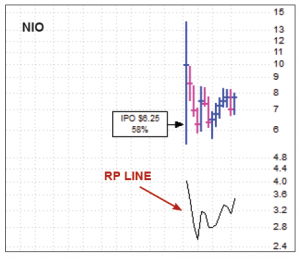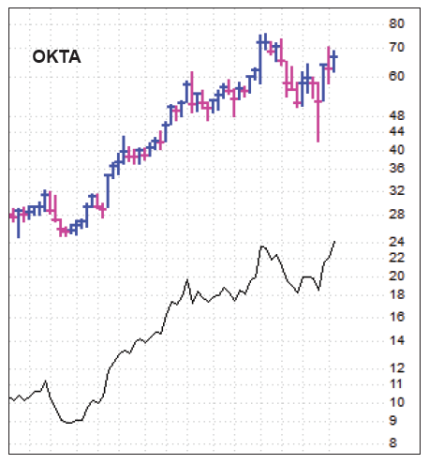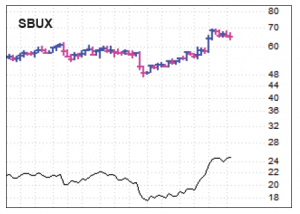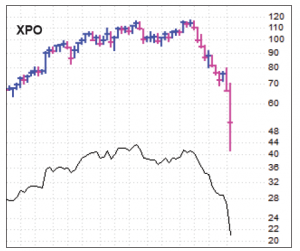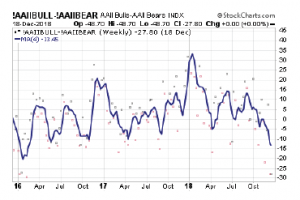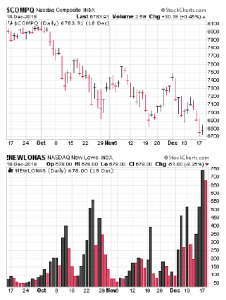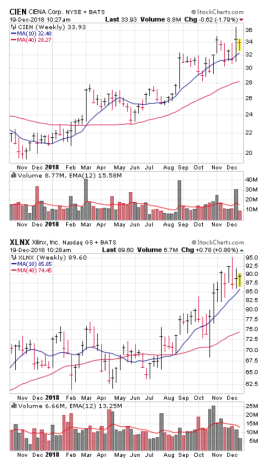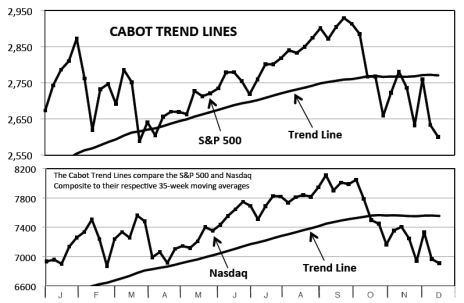While there are an endless number of things being talked about and analyzed, keeping it simple is usually better. And with the trends of the major indexes and most stocks pointed down, we remain in a defensive posture—in fact, we’ve had at least 70% cash on the sideline for the past two months.
That said, we’re ready and waiting for the next upturn. In tonight’s issue we continue to massage our watch list, review our three holdings, write about two names that are leaders of new growth “theme” and review a couple of secondary market timing indicators. When the next sustained upmove comes, there will be lots to sink our teeth into, but until then, stay patient.
Last but not least: If you celebrate, have a very Merry Christmas!
Cabot Growth Investor 1409
[premium_html_toc post_id="166675"]
Keep Your Powder Dry
Investing isn’t easy, but most people make it far more difficult than it really is. Every day all day, there are commentators and analysts on TV and dozens of articles pumped out by the online financial media dissecting recent earnings reports (FedEx was today’s disaster du jour), the Fed’s actions (hiked rates another quarter point today), oil prices (falling off a cliff), economic reports and technical market action.
But if the question is how to position your own portfolio, keeping it simple is usually better. Our Cabot Tides turned negative during the first week of October, our Cabot Trend Lines followed suit on October 19, and we had more than 70% cash in the Model Portfolio at that time. And we’ve kept at least 70% on the sideline ever since, not because of any deep insights or predictions, but because the trends of the market and most stocks have remained down.
Don’t get us wrong—we read a lot about individual companies and the market, look at tons of charts and watch a bunch of different indicators just so we’re not missing anything. But when it comes to the overarching question of whether you should be bullish or defensive, staying focused on the trends is your best move. Today, that means keeping most of your powder dry.
Of course, the greatest source of uncertainty (and investor anxiety) is the future. Is this a bear market that will last many months? A correction that’s near an end? Is the trade war going to lead to a recession?
For clues, we keep an eye on secondary indicators. As we write on page 6, we’re now seeing some relatively extreme sentiment readings (including from our own Real Money Index), which is a good contrary sign, and we’re still seeing many growth stocks etch higher lows even as the major indexes sink, which is also encouraging. That said, the broader market has yet to show the resilience typical of most sustained bottoms.
Thus, the only prediction we’re willing to make with confidence is that, given the severity of this downturn, the next sustained upmove will have a bunch of (likely new) leadership that produces great gains for investors who are keeping their eyes open and have a watch list of potential big winners at hand. We’re certainly ready and willing for that time to arrive, but until it does, cash is king.
[highlight_box]WHAT TO DO NOW: Remain defensive, but as always, keep an open mind. The Model Portfolio is about three quarters in cash (74%), though we’re still holding onto three stocks, all of which we believe can help lead the next bull move. We’re not having trouble finding resilient growth stocks with excellent stories for our watch list, but tonight, we have no new buys or sells.[/highlight_box]
Model Portfolio Update
The Model Portfolio remains in a heavily defensive stance, as it has for a while—in fact, the portfolio has held at least 70% in cash since October 19, two full months ago! Moreover, we’ve made just two purchases since the end of August, both during the brief rally attempt in late November/early December, which has been wiped out.
Of course, in this environment, sometimes even 70% cash (we’re currently holding 74%) doesn’t seem like enough. And that’s caused a few subscribers to ask: Why not go 100% in cash until the selling stops?
Our answer, first, is that it really just depends how you run your ship. There’s nothing wrong with going completely out of the market—and in this decline, it would have been the fruitful thing to do. That said, if someone was 100% in cash (instead of 70% in cash) early on in this decline, chances are they were heavily (or totally) in cash during the spring correction of this year, during the summer correction of last year, during the pre-election retreat in 2016 and after Brexit in mid-2016—all of which turned around quickly to the upside.
In other words, while it would have been better to go “all out” early on in this downturn, it would have been mostly counterproductive during the past couple of years. And that’s our experience in the long run, too—over many cycles, being totally out of the market will often have you dumping future leaders at inopportune times and create pressure to buy back in earlier than advised once the market stages a good rally, all of which can hurt performance.
But as we wrote above, there’s nothing inherently wrong with moving to 100% cash; we don’t pretend to have the bible on the exact way to manage your portfolio. If you do, though, be careful not to chase your tail during rallies and realize that, more often than not, you’ll be hugely defensive during what tend to be modest and normal market corrections.
Anyway, back to the current environment, there are some small plusses, but with the primary evidence negative, we’re still watching and waiting.
Current Recommendations
HOLD—Exact Sciences (EXAS 64)—EXAS’s chart is an “on the one hand, on the other hand” type of situation. On the one hand, the stock’s breakout attempt near the end of November failed badly as the market’s rally attempt went kaput, and the stock has been testing our rough mental stop in the upper 60s in recent days. On the other hand, the downmove, while sharp, didn’t come on huge volume (EXAS has yet to suffer a down week on above-average volume since the Pfizer announcement in August), and shares are still notching higher lows (60 in October, 62 in November and 63-plus today), even as the major indexes are sliding to lower lows. Moreover, there should be support in the 62 area (prior low, 200-day line, etc.) if it comes to that. Bottom line, because of our loss, we can’t give the stock much more rope, but we’re inclined to hold it here given our already-large cash position, the stock’s higher lows on its chart and the fact that the fundamental story is outstanding. That said, we’re also going to respect the recent action from the stock (and the market) and change our rating to Hold, and if the stock doesn’t get off its knees soon, we could sell at least half our shares to make sure the loss doesn’t grow any larger. For now, though, if you own some, just hang on.
BUY—Five Below (FIVE 97)—FIVE continues to test support in the mid-90s (prior price support and its 200-day line), and so far it’s holding up well despite some implosions among a handful of peers (including Ollie’s Bargain Outlet, which blew up on earnings two weeks ago). And some corners of Wall Street have come to the defense of the stock after its recent decline and solid quarterly report; Loop Capital upgraded shares on December 10 and Goldman actually upgraded the stock based on valuation, thinking the recent drop marks a solid entry point. (We don’t change advice based on analysts’ words, but it doesn’t hurt to have them in your corner.) Bigger picture, we want to do everything we can to hold onto our remaining shares (we’ve taken partial profits a couple of times on the way up), especially given that the business’ strength was confirmed in the quarterly report two weeks ago, with strong sales trends and, just as importantly, continued best-in-class new store economics (payback in much less than one year, a metric that’s been consistent for new store openings all across the U.S.), which is the real engine behind the rapid (20%-plus) store growth. We hesitate to make predictions, but it certainly seems that if there’s a “real” deal on U.S.–China trade relations that permanently keeps tariffs frozen (or cuts them), FIVE would benefit, with big investors allowed to affirm their long-term growth and cost estimates. But we’ll just take our cue from the chart itself—a break of support would probably have us trimming some more shares, and holding the rest. Right now, though, we’re content to hold on. And if you’re game (and have plenty of cash already on the sideline), we’re not against buying a small position as the stock is just above support.
BUY—Twilio (TWLO 86)—The latest market decline has been ferocious for sectors like financials and transports, but we’ve also seen sellers come around for stocks that still have “meat left on the bone”—i.e., those that have been acting resiliently. TWLO is no exception, as its brief poke to new highs near 100 last week was met with a quick selling wave that’s brought it back to the mid-80s. Still, similar to EXAS, we think the bigger chart picture here remains encouraging, with higher lows (63, 72 and 83) during the past three months. In fact, the stock is basically where it was when the market topped out in mid-September, a great sign of relative strength. Overall, big investors seem to be using dips as a chance to accumulate positions in what we believe is an emerging blue chip-type of name due to its massive growth potential in the quarters and years ahead. Long story short, we’re not in a rush to get out of TWLO, and there’s a good chance that any tradable market low will again see buyers plow back into the stock; with TWLO a few points above support, we’re still OK grabbing a few shares (assuming you are sitting on a large cash position) with a tight stop. That said, we do have a loss, which we don’t want to play around with much in a weak tape. We’re OK with TWLO here, but want to see support appear on further dips.
Watch List
Alteryx (AYX 61): We write about one possible new leading theme (5G and webscale infrastructure) on page 7, but another is the broadening use of advanced analytics. AYX (public just since March 2017) is a new leader in the field (50%-plus revenue growth, earnings just leapt into the black), and despite a good run earlier this year, remains perched near its highs.
Ciena (CIEN 33): CIEN briefly hit new highs last week following another quarter of accelerating sales and earnings growth. The pullback since then isn’t surprising given the environment; we think shares want to head higher if the market allows it. See more on page 7.
Etsy (ETSY 50): ETSY has a one-of-a-kind ecommerce platform that’s become the go-to marketplace to buy and sell unique, handcrafted goods. Growth remains impressive, as does the stock, which has retreated a bit over the past week but is still miles above its October and November lows.
MongoDB (MDB 86): MDB remains extremely volatile, but very resilient; it’s one of the few stocks that’s actually above its September/October peak right now, despite the market’s meltdown. Just as Twilio has a communications platform that looks like the standard for businesses of all sizes, MongoDB’s database platform looks like the next big thing for the corporate world.
PayPal (PYPL 84): PYPL hit its low in early October, is above its 50-day and 200-day lines and is a leader in as dependable a growth area (online payments and money transfers) as there is. The longer the stock can hold up, the greater the chance it can be a steady liquid leader of the next market uptrend.
ProShares Ultra S&P 500 Fund (SSO 93): We wouldn’t be touching a leveraged long index fund here, but after a bottoming process and some buy signals, it’s a good bet the next uptrend could go far. We’ve used funds like SSO as ways to get a foot in the door of new market uptrends many times in the past, and are planning to do so next time, too.
Tesla (TSLA 333): TSLA has finally taken a hit, though it remains north of its 50-day line. It likely needs time to set up, but remains in good shape overall.
Workday (WDAY 156): WDAY is still hanging around its summertime highs, which is impressive. Along with PYPL, this looks like a potential liquid growth leader down the road.
Xilinx (XLNX 85): Chip stocks have actually shown a smidge of relative strength of late, and XLNX is definitely a leader in the group. We think it (and CIEN) are among the best ways to play what could be a new leading theme. See page 7 for more.
Zscaler (ZS 39): ZS and OKTA (see below) look like a new wave of security growth stocks, with cloud security (ZS) and identity (OKTA) products that are in high demand from companies as they transition to the cloud and have more mobile workforces. One analyst opined this week that ZS (which has $214 million in revenue over the past year) could reach $1 billion in revenue within four years.
Other Stocks of Interest
The stocks below may not be followed in Cabot Growth Investor on a regular basis. They’re intended to present you with ideas for additional investment beyond the Model Portfolio. For our current ratings on these stocks, see Updates on Other Stocks of Interest on the subscriber website or email mike@cabotwealth.com.
Nio Inc. (NIO 6.8) — Nio Inc. is a Chinese automaker that has its eye on the high end of the electric car market. The company has been all sizzle and no steak in recent years, with a high-performance supercar (the EP9) to generate publicity. But its seven-seater SUV dubbed the ES8, is now in production and selling very well. The company brought in $214 million in Q3, with startup expenses causing projected big losses for the year, but analysts see revenues exploding to $2.5 billion next year. After coming public at 6 in mid September, NIO ran as high as 14 a couple of days later, then settled down into a post-IPO base with support at 6 and resistance at 8. It’s anybody’s guess how a car company whose lead product has a base price of $64,500 will fare in China, as a slowing economy has car sales under pressure. But it’s still a big market and focusing on the premium buyer looks like a wise strategy. This one is worth keeping an eye on.
Okta (OKTA 63) — Okta is a computer security specialist with a focus on the particular challenges of safeguarding networks when employees are working remotely and around the world. Okta’s cloud-based identity and access management (IAM) solutions keep sensitive information safe, and the company’s partner programs with system integrators is adding new customers and recurring revenue (which now totals over $100 million per year). We like that its solutions are becoming a must-have for many big corporations as emplyees access key data from anywhere and from any device. The company’s very strong quarterly report on December 5 led to a huge spike in volume the next day. Of all the stocks we’ve sold since September, OKTA is the one we wish we had back. The story is great, analysts foresee 51% sales growth this fiscal year (which ends in January) and 32% next year. And finally, the stock itself is holding up well in a carnivorous market.
Starbucks (SBUX 64) — From late 2015 through the middle of 2018, Starbucks was definitely a decaffeinated stock. That’s not surprising given that it had soared from 3 in late 2008 to 60 in October 2015. But after plunging to below 50 in June, SBUX has shown excellent strength, moving higher in an orderly way to 59 as November began, then gapping up on spiking volume to reach 68 on November 8. Then on December 13, the company staged an analyst day that revealed plans for a new delivery service (from around a quarter of U.S. company-operated stores) via Uber Eats starting in 2019, expansion of its Chinese delivery program, the debut of a virtual Starbucks store in China with Alibaba partnership and accelerated innovation in cold beverages. Management also reaffirmed 2019 revenue and earnings targets. With a 27 P/E and a 2.2% forward dividend yield, SBUX isn’t a hot growth pick, but there are some catalysts for growth here and the long-term breakout is intriguing.
XPO Logistics (XPO 52) — XPO Logistics, the company that is trying to consolidate the global trucking industry via takeovers and buyouts, is a name we dabbled in once or twice, making okay money (although we should have made more). XPO was a power stock that ran from 44 to 92 in 2017 and blasted to 116 in late September 2018. With four quarters of double-digit revenue growth and estimates for this year’s earnings at 72%, it looked like a can’t lose proposition. But we’re writing about it today for the Big Lesson it teaches: No matter how good the story or how high your long-term profit, any stock can hit an iceberg. XPO started down in October, and cratered at 41 last week for a 62% haircut. Don’t let a stock do that to you. And when looking for new leaders, ignore the siren call of “buying low.”
Secondary Indicators: Sentiment Improving, but Broad Market Isn’t
We continue to monitor a bunch of secondary measures for market timing purposes—while we rarely trade off them, they often are the first things to “flash” before a sustainable market bottom. If nothing else they can give us a better idea if a new market rally (whenever one begins) might have the ability to morph into a major uptrend.
The good news is that, as the market has worsened, so has sentiment—more and more investors are throwing in the towel, which will create buying power during the next upmove. Our own Real Money Index, for instance, just recorded its largest single-week outflow in 25 years! Some of that was seasonal, as December often sees big outflows (and, occasionally, inflows), but a record is a record.
We also saw an extreme reading from the AAII survey last week. While it’s not a huge sample, the survey has a useful history as an indicator, and last week, the percent of respondents who were bearish was the largest in more than five years! Even the four-week average of bulls less bears has nosed to its lowest level since the major market bottom in February 2016. Throw in some anecdotal signs (the front page of the New York Times’ Sunday Style Section this weekend: “Assume Crash Position”) and there’s evidence most investors are jumping ship.
That’s good, but the other piece of secondary evidence we track closest—the action of the broad market—isn’t as encouraging. Shown here is a chart of the Nasdaq Composite versus the number of stocks hitting new lows on that exchange; while the peak October reading held up for a few weeks, we’ve seen even greater numbers of new highs this week. And it’s a similar story for the NYSE (our old Two-Second Indicator).
We’ll continue to monitor these (and a couple other) secondary measures for hints as to when the sellers are running out of ammo. Today, sentiment offers encouragement, but we’ll likely need to see the broad market show relative strength before the market gets going in a real way.
A New Theme to Watch
While we patiently wait, mostly on the sideline, we’re aiming to identify potential leaders and, ideally, “themes” that could produce some new leaders for the next uptrend. One is the buildout of 5G capabilities and so-called webscale infrastructure, which allows Internet content and cloud providers to provide better experiences to customers and connect users to content more rapidly. Both Ciena (CIEN) and Xilinx (XLNX) look like leaders of this movement.
Ciena has invested a ton in R&D in recent years and has been steadily gaining market share in a handful of fast-growing niches. The stock was a nothingburger for years, but it broke out of a three-year base in August, hasn’t broken its 50-day line since and nosed to new highs last week after earnings showed another acceleration in sales (up 21%) and earnings (up 66%) growth as demand for its products remained strong. Analysts see earnings up 35% over the next year and another 25% in 2020.
Xilinx, on the other hand, is a chipmaker that’s also had a decent (but not exciting) past. A new CEO, though, has emphasized growth areas like data center and 5G-related chips; these areas should grow 20% or more annually for at least the next few years, compared to single-digit growth in its highly profitable core markets. Similar to Ciena, Xilinx’s sales and earnings growth are both accelerating (up 19% and 30% in the latest quarter, respectively), though its earnings estimates (up 9% next year) seems conservative.
As time goes by, there could be another stock or two in this theme that catches our eyes, but CIEN and XLNX are two top dogs—CIEN attracts us a bit more due to the chart and slightly better growth numbers, but both are on our watch list and we’d like to own one of them when the market turns up, assuming both stocks remain resilient. WATCH.
Cabot Market Timing Indicators
The latest leg of this market downturn continues, with all major indexes skidding to new multi-month lows. Secondary indicators (sentiment, oversold, etc.) tell us to keep our eyes open, but the onus remains on the bulls to step up to the plate.
Cabot Trend Lines: Bearish
The biggest black mark from a timing perspective remains our Cabot Trend Lines, which have now been bearish for nearly two months and remain far from a new buy signal today—at last week’s close, the S&P 500 (by 6.2%) and Nasdaq (by 8.5%) closed well below their respective 35-week moving averages. That’s not to say the market can’t turn around, but until the longer-term trend becomes positive, it’s best to go slow and hold plenty of cash.
Cabot Tides: Bearish
Our Cabot Tides returned to the negative side of the fence two weeks ago and remain bearish today, with all five of the indexes we track (including S&P 400 MidCap, shown here) clearly below their lower (25-day) moving averages. Things can change quickly if the bulls return, but at this point, both of the market’s main trends are pointed down, so the odds continue to favor lower prices ahead.
Cabot Real Money Index: Neutral
As we discuss on page 7, more sentiment measures are beginning to reach extremes, and our own Real Money Index is included in that batch—last week’s outflow from equity funds and ETFs was the largest in 25 years! Some of that is seasonal, but contrast that with the huge spike in January, which turned out to be the high water mark for many stocks and sectors. It’s a positive to see more investors are throwing in the towel.
[premium_html_footer]
Send questions or comments to mike@cabotwealth.com.
Cabot Growth Investor • 176 North Street, Post Office Box 2049, Salem, MA 01970 • www.cabotwealth.com
All Cabot Growth Investor’s buy and sell recommendations are made in issues or updates and posted on the Cabot subscribers’ website. Sell recommendations may also be sent to subscribers as special bulletins via email and the recorded telephone hotline. To calculate the performance of the portfolio, Cabot “buys” and “sells” at the midpoint of the high and low prices of the stock on the day following the recommendation. Cabot’s policy is to sell any stock that shows a loss of 20% in a bull market (15% in a bear market) from our original buy price, calculated using the current closing (not intra-day) price. Subscribers should apply loss limits based on their own personal purchase prices.
Charts show both the stock’s recent trading history and its relative performance (RP) line, which shows you how the stock is performing relative to the S&P 500, a broad-based index. In the ideal case, the stock and its RP line advance in unison. Both tools are key in determining whether to hold or sell.
THE NEXT CABOT GROWTH INVESTOR WILL BE PUBLISHED JANUARY 3, 2019
We appreciate your feedback on this issue. Follow the link below to complete our subscriber satisfaction survey: Go to: www.surveymonkey.com/marketlettersurvey
Neither Cabot Wealth Network nor our employees are compensated by the companies we recommend. Sources of information are believed to be reliable, but are in no way guaranteed to be complete or without error. Recommendations, opinions or suggestions are given with the understanding that subscribers acting on the information assume all risks. © Cabot Wealth Network. Copying and/or electronic transmission of this report is a violation of U.S. copyright law. For the protection of our subscribers, if copyright laws are violated, the subscription will be terminated. To subscribe or for information on our privacy policy, call 978-745-5532, visit www.cabotwealth.com or write to support@cabotwealth.com.
[/premium_html_footer]






